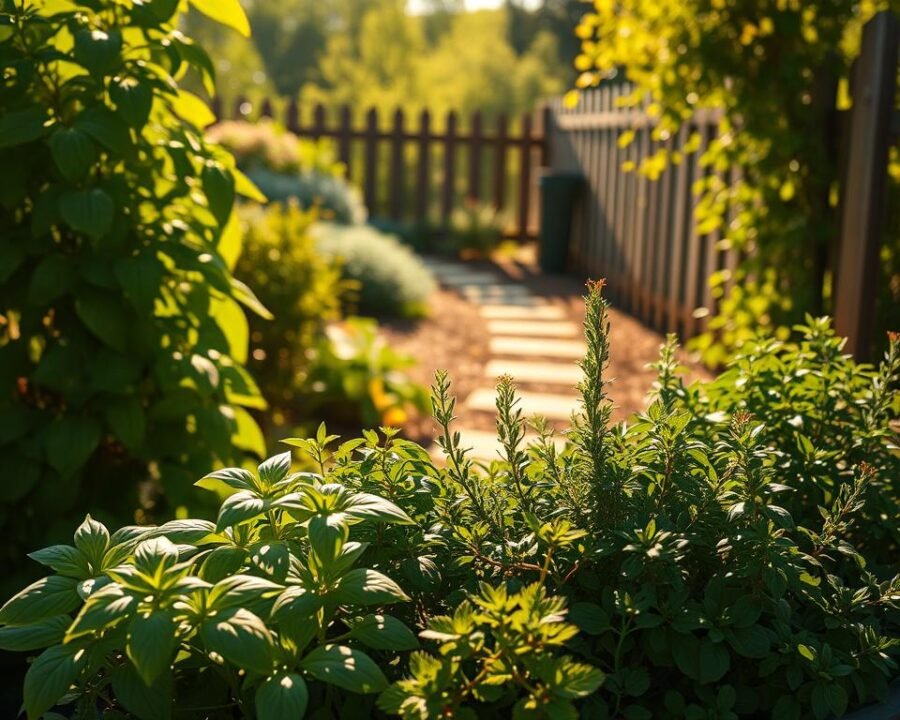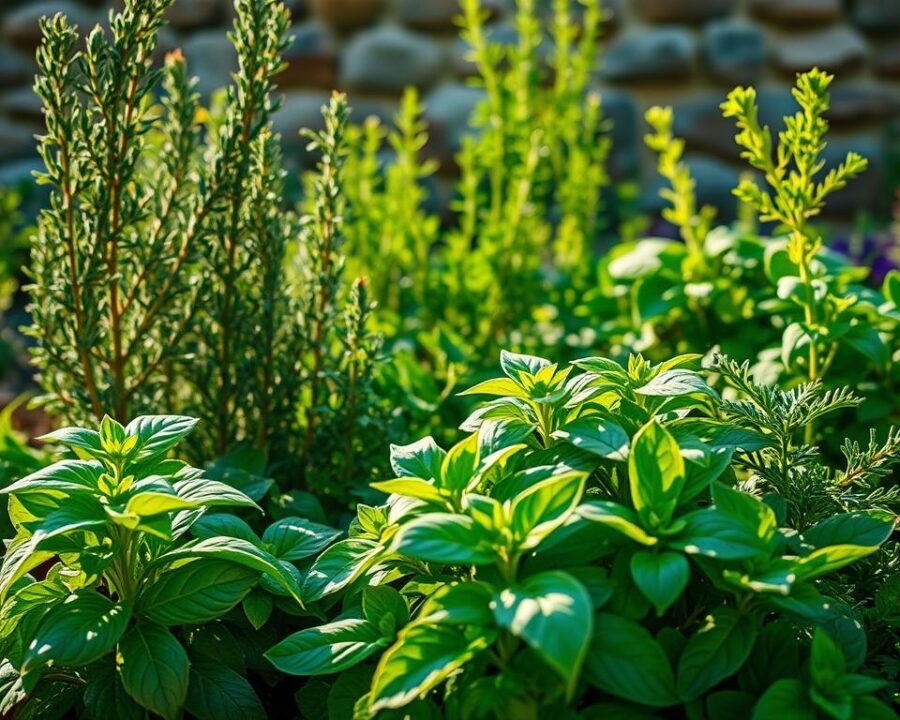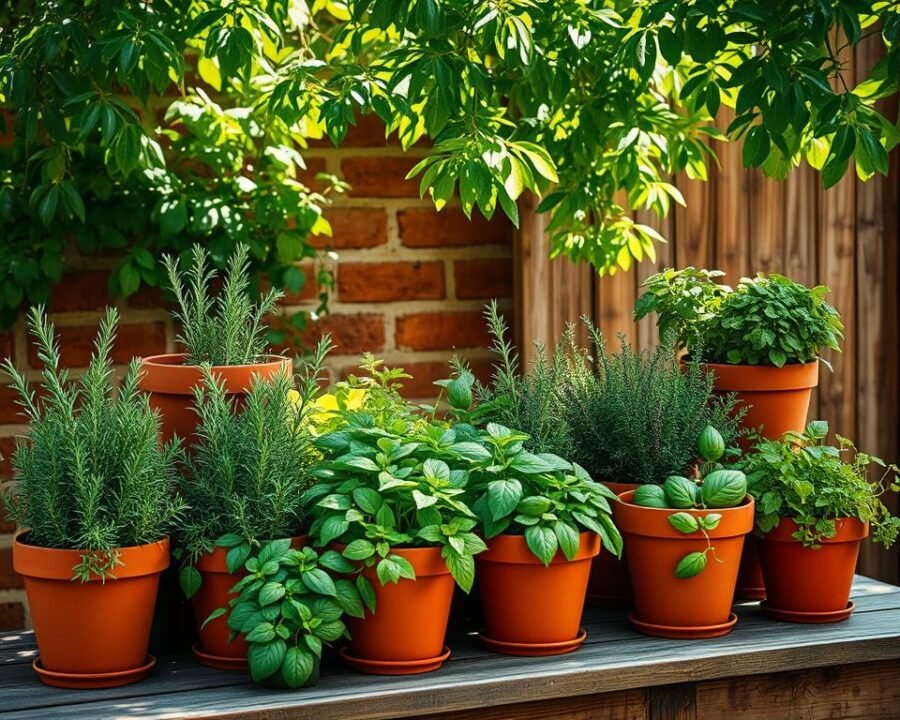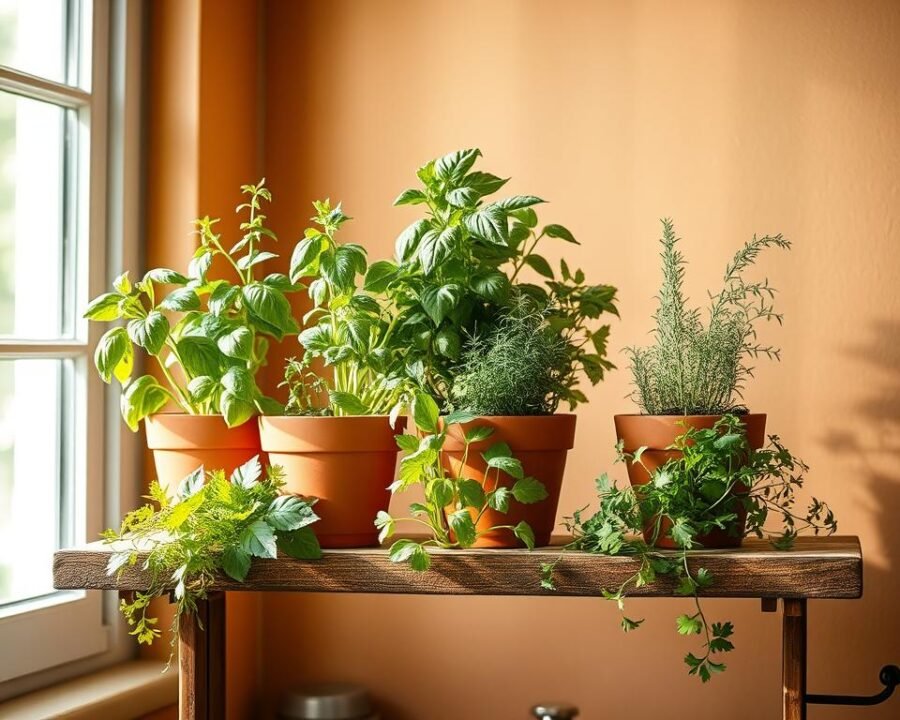There’s something magical about plucking fresh leaves straight from your own mini oasis. Whether it’s a sunny windowsill or a cozy balcony, growing herbs brings joy and flavor to everyday meals. No backyard? No problem. Even the smallest spaces can thrive with a little creativity.
We believe everyone deserves access to homegrown goodness. Starting with easy-to-grow options like chives or basil makes gardening simple for beginners. Imagine skipping the grocery store and seasoning dishes with herbs picked minutes before cooking. That’s the kind of freshness money can’t buy.
Our mission is to bring back the tradition of kitchen gardening, one small pot at a time. Urban dwellers and apartment renters can enjoy lush greenery without sacrificing space. Let’s explore how to turn any corner into a vibrant, edible retreat.
Key Takeaways
- Herb gardens fit any space, from balconies to windowsills.
- Beginner-friendly plants like chives require minimal care.
- Freshly picked herbs enhance flavor better than store-bought ones.
- Small-space solutions make gardening accessible for urban living.
- Growing your own reduces reliance on supermarket purchases.
Why Start a Herb Garden?
Fresh flavors at your fingertips—growing herbs at home transforms cooking and saves money. A single basil plant costs less than weekly grocery packets, adding up to $300+ yearly savings. Plus, 92% of varieties flourish in under 4 square feet, perfect for tight spots.
The Benefits of Growing Your Own Herbs
Beyond savings, fresh-picked herbs outshine store-bought in taste and nutrition. Rosemary and thyme even purify indoor air, while mint naturally deters pests from nearby plants. One reader’s 2’x4’ balcony garden now feeds a family of four with minimal effort.
Herbs: Perfect for Small Spaces
Vertical pallet gardens or window boxes maximize limited areas. Pollinator-friendly varieties like lavender support local ecosystems too. Whether in a kitchen corner or on a fire escape, herbs adapt to any space to grow—no backyard required.
Planning Your Herb Garden
Smart planning turns any corner into a thriving green space. Whether indoors or out, success starts with understanding your environment. A few simple steps ensure your plants get what they need to grow strong.

Choosing the Right Location
Mediterranean herbs like rosemary demand 6+ hours of direct sunlight. South-facing windows or balconies are ideal. For heavy clay soil, mix in 30% grit to improve drainage.
Even a *north-facing* spot can work with shade-tolerant herbs. Try planting dill under taller crops like tomatoes. One urban gardener transformed a fire escape into a lush retreat with creative positioning.
Assessing Your Space and Sunlight
Track light patterns for three days with a sun-mapping exercise. Use a laser thermometer to spot microclimates. Soil test kits like Rapitest or Luster Leaf reveal pH levels quickly.
Kitchen windowsills often provide enough light for basil or chives. If space is tight, vertical planters or hanging baskets maximize every inch. The right setup makes all the difference.
Best Herbs to Grow for Beginners
Starting with simple plants makes growing herbs enjoyable for anyone. These varieties thrive with minimal care, offering quick rewards. From sunny windowsills to shady corners, there’s a perfect match for every space.

Easy-to-Grow Herbs Like Basil and Chives
Basil and chives are ideal for first-timers. Basil grows 2 inches weekly with proper sunlight and water. Chives sprout in just 8 weeks, even in small pots.
Popular basil varieties include:
- Genovese: Bold flavor for pesto
- Thai: Spicy twist for stir-fries
- Lemon: Bright citrus notes
Mediterranean Herbs: Rosemary and Thyme
These hardy plants love sunlight and dry soil. Rosemary survives temperatures as low as -10°F once established. Propagate it easily from cuttings:
- Snip a 4-inch stem
- Remove lower leaves
- Plant in sandy soil
Herbs That Thrive in Shade
Parsley yields 8 harvests yearly even in low light. Pair it with shade-loving companions:
- Chervil: Delicate anise flavor
- Vietnamese coriander: Peppery kick
Oregano takes longer (16 weeks) but rewards patience with robust flavor.
Creative Container Ideas for Herb Gardens
Containers unlock endless possibilities for growing fresh flavors in any setting. Whether you’re working with a balcony or a windowsill, the right vessel keeps plants healthy and stylish. Let’s explore designs that blend function with personality.

Using Pots, Window Boxes, and Raised Beds
Food-grade stainless steel pots last over a decade, resisting rust and wear. Window boxes add charm to railings, while raised beds improve drainage for Mediterranean herbs. For mint, ensure containers are at least 12 inches deep to prevent overcrowding.
Upcycled Containers: Tin Baths and Wine Boxes
Old tin baths make rustic planters—drill holes for drainage every 6 inches. Wine boxes lined with copper mesh prevent root rot. One gardener transformed a filing cabinet into a rolling herb cart, complete with locking casters for easy sunlight chasing.
Herb Container Designs for Small Spaces
Vertical stacks of galvanized stainless steel buckets save floor space. Self-watering trays cut maintenance by 40%, ideal for busy urban dwellers. For tight corners, try hanging baskets with trailing varieties like oregano or thyme.
- Mobile solutions: Carts with wheels adapt to changing light.
- Soil depth guide: Basil thrives in 8 inches; rosemary needs 10+.
- FDA-approved materials: Avoid treated wood near edible plants.
Soil, Watering, and Care Tips
Healthy plants start from the ground up—literally. The right foundation keeps herbs thriving season after season. We’ll share simple ways to check conditions and adjust care as needed.
Choosing the Right Soil Mix
Most varieties prefer slightly acidic soil (pH 6.0-7.0). Test kits from garden centers give instant readings. For Mediterranean types like rosemary, mix 30% perlite into potting soil for perfect drainage.
Try this recipe matrix:
- Basil/mint: 2 parts potting soil, 1 part compost
- Thyme/oregano: Add 1 part sharp sand
- Container tip: Food-grade galvanized stainless steel pots prevent soil contamination
Watering Herbs: Avoiding Over-Watering
Drowning roots causes more harm than drought. Push a finger 1 inch into soil—if dry, it’s time to water. Moisture meters are 90% accurate but cost 3x more than the finger test.
Morning watering reduces evaporation. Always water at the base, not leaves. In humid climates, space out sessions to avoid over-watering herbs.
Feeding and Pruning Your Herbs
Seaweed feed every 3 weeks increases yields by 25%. For homemade options, brew compost tea in 5-gallon buckets using:
- 1 cup finished compost
- 5 gallons rainwater
- 48-hour steep time
Prune thyme weekly but sage monthly. Winter protection? Hessian wraps beat plastic cloches for airflow. Your plants will reward care with bushier growth and better flavor.
Harvesting and Using Your Herbs
Morning dew glistening on fresh leaves signals it’s time for the most rewarding step – harvest. This is when weeks of care transform into vibrant flavors for your kitchen. With proper techniques, you’ll maximize both yield and taste from every plant.
Perfect Timing for Peak Flavor
Early mornings deliver 20% more essential oils in leaves compared to afternoon picking. Use sharp scissors for clean cuts that promote regrowth. For basil, snip above leaf nodes to encourage bushiness.
Two main methods work best:
- Stem-cutting: Ideal for woody varieties like rosemary
- Leaf-picking: Best for tender plants like basil
Preserving the Bounty
Freezing captures freshness better than drying for most varieties. Try herb ice cubes – they stay flavorful for 6 months in the freezer. Frozen basil keeps its bright color, perfect for winter soups.
For dehydrating:
- Set temperature to 95°F for delicate herbs
- Increase to 125°F for tougher leaves
- Store in airtight jars with silica packets
From Garden to Table
Summer salads shine with fresh herbs right from your windowsill. Try these classic pairings:
- Tarragon with roasted chicken
- Dill in potato salads
- Mint with fruit desserts
For infused oils, always add lemon juice or vinegar to prevent botulism. One healthy plant typically yields enough for 8 frozen cubes – plenty to flavor meals all season.
Conclusion
Growing fresh flavors at home starts small but often grows into a lifelong passion. 78% of beginners expand their setups within two years, harvesting an average of 1.5 pounds per season. From those first sprouts to vibrant harvests, every step brings joy.
Ready for more? Join our growing challenge to share progress with fellow enthusiasts. Explore advanced methods like hydroponics later—for now, savor the victory of homegrown taste. Your pasta sauce will never be the same once you’ve used leaves picked minutes before cooking.
Tag us in your first harvest photos! Let’s celebrate the wins together as a community. Whether it’s a single pot or a windowsill full, every plant counts.
